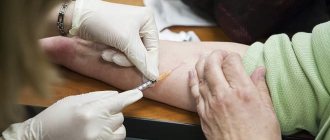Use of the drug Nadroparin calcium
Injected subcutaneously into the subcutaneous fatty tissue of the abdomen. To prevent thromboembolism, a dose of 0.3 ml is administered once a day during the entire risk period (at least 7 days); The first administration is prescribed 2–4 hours before the start of surgery. In orthopedic surgery, it is administered once a day, daily, depending on body weight in the following doses: patients weighing up to 50 kg in the preoperative period and for 3 days after surgery - 0.2 ml, in the postoperative period (starting from the 4th day) - 0.3 ml; for patients weighing 51–70 kg, 0.3 and 0.4 ml, respectively; 71–95 kg - 0.4 and 0.6 ml.
Nadroparin Calcium
Do not administer intramuscularly.
Heparin-induced thrombocytopenia
Since there is a possibility of developing HIT when using heparins, platelet levels must be monitored during the entire course of treatment with nadroparin calcium.
Rare cases of HIT, including severe HIT, have been reported, which may be associated with arterial or venous thrombosis. The possibility of developing HIT is important to consider in the following cases:
- with thrombocytopenia;
- with a significant decrease in platelet levels (by 30-50% compared to normal values);
- with negative dynamics of clinical manifestations of thrombosis for which the patient is receiving treatment;
- if thrombosis occurs during treatment of phlebitis, pulmonary embolism, thrombosis of the arteries of the lower extremities, myocardial infarction or stroke;
- with disseminated intravascular coagulation syndrome.
In these cases, it is necessary to immediately organize continuous monitoring of platelet levels. The use of nadroparin calcium should be discontinued.
These effects are of an immunoallergic nature and are usually observed between the 5th and 21st days of treatment, but may occur earlier if the patient has a history of heparin-induced thrombocytopenia. Isolated cases of HIT have also been reported after 21 days of treatment.
If there is a history of HIT (against the background of conventional or low molecular weight heparins), treatment with nadroparin calcium can be prescribed if necessary. However, strict clinical monitoring and, at a minimum, daily platelet count measurement are indicated in this situation. If thrombocytopenia occurs, use of nadroparin calcium should be discontinued immediately.
If thrombocytopenia develops during treatment with heparins (regular or low molecular weight), the possibility of prescribing anticoagulants of other groups should be considered. If other drugs are not available and anticoagulant treatment must be continued, another low molecular weight heparin may be used. In this case, the platelet count in the blood should be monitored daily and treatment should be discontinued as soon as possible, since signs of the original thrombocytopenia continue to be observed after changing the drug (see section "Contraindications").
Monitoring platelet aggregation based on in vitro tests is of limited value in the diagnosis of HIT.
Caution should be exercised when prescribing nadroparin calcium in the following situations as they may be associated with an increased risk of bleeding:
- liver failure;
- severe arterial hypertension;
- a history of peptic ulcer or other organic lesions that may bleed;
- chorioretinal vascular diseases;
- postoperative period after surgery on the brain, spinal cord or eyes;
- elderly age;
- patients weighing less than 40 kg.
Laboratory monitoring
Monitoring platelet levels in patients receiving LMWH and with risk factors for HIT
To ensure timely detection of HIT during treatment, it is optimal to monitor patients’ condition as follows:
After surgery or trauma (within the last 3 months): When using nadroparin calcium for treatment or prophylaxis, regular biological monitoring is necessary, since the incidence of HIT in such patients is 0.1% and even > 1%. Determination of platelet concentration must be carried out:
- before starting treatment with LMWH or in the first 24 hours after starting treatment;
- 2 times a week during the first month of treatment (period of maximum risk);
- 1 time per week until the end of treatment in case of long-term therapy.
In the absence of surgery or trauma (within the last 3 months): when using nadroparin calcium for treatment or prevention, regular biological monitoring is necessary in the following cases:
- with a history of UFH or LMWH therapy in the last 6 months - due to the incidence of HIT > 0.1% and even > 1%;
- in the presence of concomitant diseases, in view of the potential danger of HIT in such patients.
In other cases, due to the low incidence of HIT (<0.1%), determination of platelet concentration should be carried out:
- before starting LMWH treatment or in the first 24 hours after starting therapy;
- when specific clinical signs of HIT appear (arterial or venous thromboembolism, painful skin lesions at the injection site, signs of allergy and hypersensitivity during therapy). Patients should be advised of the possibility of such clinical signs and the need to contact their doctor if they occur.
— The possibility of developing HIT should be considered when the platelet count decreases to < 150,000/mm3 (150 x 10%) or by 30-50% compared with the initial value.
— In case of mild renal failure (creatinine clearance > 50 ml/min), there is no need to reduce the dose of nadroparin calcium.
Any significant decrease in platelet levels (30-50% of the initial value) requires urgent attention before the level reaches the critical threshold. If your platelet count is low, you should:
1) immediately assess the dynamics of thrombocytopenia;
2) discontinue heparin if a continued decrease in platelet levels is confirmed in the absence of other obvious causes of thrombocytopenia;
3) prevent or treat thrombotic complications of HIT.
If further anticoagulant treatment is necessary, heparin should be replaced with a different class of anticoagulant at a prophylactic or therapeutic dose, depending on the situation.
If heparin is replaced by vitamin K antagonists (VKAs), the latter should be prescribed only after platelet levels have normalized, otherwise there is a risk of increased thrombotic effect.
Replacement of heparin with vitamin K antagonists
— Careful clinical and laboratory monitoring (prothrombin time according to Quick and INR) should be ensured to monitor the effect of VKAs.
— Since the full effect of vitamin K antagonists takes a period of time to become apparent, heparin should be continued at an equivalent dose for as long as necessary to achieve the INR level acceptable for this indication on two consecutive measurements.
Special patient groups
Patients with kidney failure
Since nadroparin calcium is primarily excreted by the kidneys, this leads to a decrease in the excretion of nadroparin calcium in patients with renal insufficiency (see section “Pharmacokinetics: Patients with renal insufficiency”). Therefore, in this group of patients there is a greater risk of bleeding and greater care is required during treatment. The decision to reduce or maintain the dose for a patient with a creatinine clearance of 30 to 50 ml/min is made by the physician, who must assess the individual risk of bleeding for the patient compared with the risk of thromboembolism (see section "Dosage and Administration").
Elderly patients
Before starting treatment with nadroparin calcium, it is necessary to assess renal function (see section "Contraindications").
Hyperkalemia
Heparins may suppress aldosterone secretion, which may lead to hyperkalemia, especially in patients with elevated blood potassium or in patients at risk for elevated blood potassium, such as patients with diabetes mellitus, chronic renal failure, metabolic acidosis, or patients taking drugs that can cause hyperkalemia (eg, angiotensin-converting enzyme inhibitors, nonsteroidal anti-inflammatory drugs (NSAIDs)).
The risk of hyperkalemia increases with long-term therapy but is usually reversible with discontinuation.
In patients at risk, blood potassium levels should be monitored.
Spinal/epidural anesthesia/lumbar puncture and related medications
The risk of spinal/epidural hematomas after use of nadroparin calcium, leading to neurological disorders, including prolonged or permanent paralysis, is increased in patients with installed epidural catheters or concomitant use of other drugs that may affect hemostasis, such as NSAIDs, antiplatelet agents, or other anticoagulants. The risk also increases with traumatic or repeated epidural or spinal taps.
Therefore, the issue of the combined use of neuraxial blockade and anticoagulants should be decided individually after assessing the benefit/risk ratio in the following situations:
- in patients already receiving anticoagulants, the need for spinal or epidural anesthesia must be justified;
- in patients planning elective surgery using spinal or epidural anesthesia, the need for anticoagulants must be justified.
If the patient is undergoing a lumbar puncture or spinal or epidural anesthesia, an interval of at least 12 hours should be maintained between the administration of nadroparin calcium at prophylactic doses or 24 hours at therapeutic doses and the insertion or removal of the spinal/epidural catheter or needle. Longer intervals may be considered for patients with renal impairment.
Careful monitoring of the patient is necessary to identify signs and symptoms of neurological disorders, such as back pain, sensory or motor disturbances (numbness or weakness of the lower extremities), bladder and/or bowel problems. Patients should be instructed to notify their physician if neurological symptoms occur.
If disturbances are detected in the patient's neurological status, urgent appropriate therapy is required, including spinal cord decompression.
Salicylates. non-steroidal anti-inflammatory drugs and antiplatelet agents
When preventing or treating venous thromboembolism, as well as when preventing blood coagulation in the extracorporeal circulatory system during hemodialysis, co-administration of nadroparin calcium with drugs such as acetylsalicylic acid, other salicylates, NSAIDs and antiplatelet agents is not recommended, because this may increase the risk of bleeding. If such combinations cannot be avoided, careful clinical and biological monitoring is necessary.
In clinical studies in patients with unstable angina and myocardial infarction without Q wave elevation, nadroparin calcium was used in combination with acetylsalicylic acid in doses not exceeding 325 mg per day (see section "Dosage and Administration").
Skin necrosis
Skin necrosis has been reported very rarely. It was preceded by purpura or infiltrated or painful erythematous macules with or without the presence of general signs. In such cases, treatment should be stopped immediately.
Patients with mechanical valve prostheses (including pregnant women)
The use of nadroparin calcium for the prevention of thrombus formation in patients with mechanical artificial heart valves has not been studied sufficiently. Due to the impossibility of assessing the effectiveness and safety, the use of the drug nadroparin calcium to reduce the risk of thrombosis and embolism in patients with mechanical artificial heart valves is not recommended.
Pregnant women with mechanical artificial heart valves have a high risk of developing thrombosis and embolism. The limited experience with the use of nadroparin calcium does not allow us to recommend the use of the drug nadroparin calcium to reduce the risk of thrombosis and embolism in pregnant women with mechanical artificial heart valves.
Low body weight
Before starting treatment with nadroparin calcium, renal function should be assessed (see section "Patients with renal failure").
Obese patients
Obese patients have an increased risk of thromboembolic complications. The safety and effectiveness of prophylactic doses of nadroparin calcium have not been fully assessed in obese patients (body mass index > 30 kg/m2) and recommendations for dose selection are not available. Therefore, monitoring these patients for signs and symptoms of thromboembolic complications is recommended.
Children
Currently, there is insufficient clinical data on the effectiveness and safety of the use of nadroparin calcium in patients under 18 years of age, and therefore the use of nadroparin calcium in children and adolescents is not recommended.

![Table 1. Bioavailability (absorption) of various organic forms of calcium within 2 hours after oral administration in the experiment [22]](https://laram-halal.ru/wp-content/uploads/tablica-1-biousvoyaemost-absorbciya-razlichnyh-organicheskih-form-kalciya-v-techenie-330x140.jpg)

